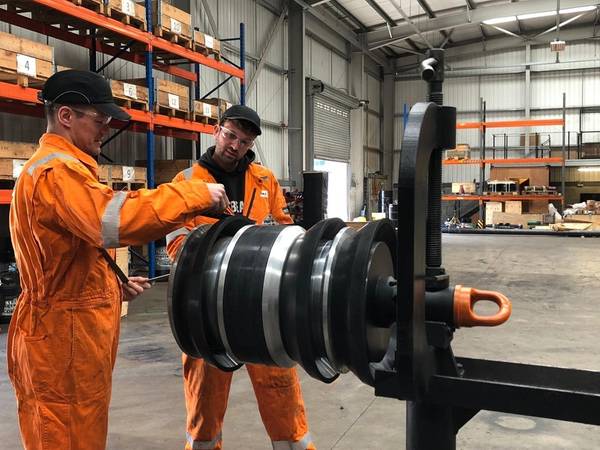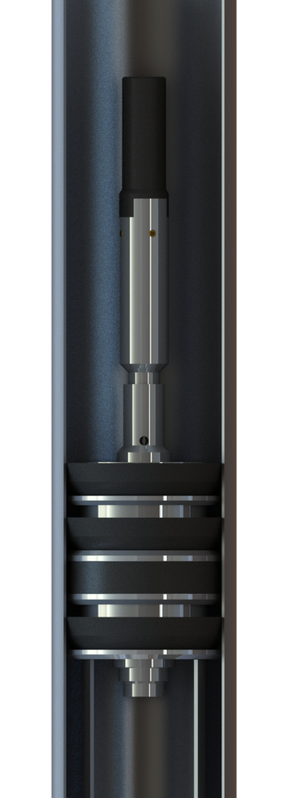
Confidently setting an environmental barrier for plugging and abandonment (P&A) operations has traditionally been limited to mechanical bridge plugs and inflatable devices. At a fraction of the cost of conventional tools, Coretrax, the wellbore clean-up and abandonment specialist, is continuing to meet demand for its CX-Enviroplugs as a safer, simpler and more cost-effective alternative for big bore cement plug placement.
Originally designed to act as a simple base for cement, the plug is particularly suited to wells requiring an environmental barrier to prevent the leakage of oil-based mud.
Available in sizes 18-5/8” to 20”, the three-finned tool, which allows self-centralization, now incorporates a compression set elastomer element, enabling pressure testing of up to 1,000psi to be achieved. The design is also able to pass through a smaller wellhead restriction. Manufactured from drillable materials, the device also has a one-way valve and bypass ports across the plug to prevent surging when running in hole.
With a patent pending, eight plugs have so far been run across Norwegian and UK P&A projects in the North Sea. The most recent was completed in the Southern North Sea for Spirit Energy.
The ST-1 platform in the Greater Markham Area of the Southern North Sea, for example, ceased gas production in April 2016. Discovered in 1984, the field extends over license blocks 49/5a and 49/10b on the UKCS and license blocks J3b and J6 on the Dutch continental shelf. Six wells and a single installation are connected via two pipelines to the Markham J6A installation in the Dutch sector, approximately 5.6 kilometers from the ST-1 installation.
On reaching the end of its economic life, ST-1 was put in warm suspension mode with all wells shut-in and disconnected from the platform pipework. In March 2018, P&A of the wells was performed by the Paragon B391 jack-up and completed in around 100 days.
Coretrax delivered bridge plugs for the permanent abandonment of the wells. In April 2018, a 13-3/8” CX-2 bridge plug was run in well B2. As a permanent cast iron bridge plug, the CX-2 is designed to set with a combination of hydraulic pressure and mechanical pull and boasts a built-in setting mechanism for greater efficiency. The slick OD and large ID of the released running tool minimizes cement disturbance when pulling out of hole. This makes it ideal for cement plug operations.
The bridge plug was made up and run in hole to a setting depth of 232 meters and set by Spirit Energy personnel as per Coretrax procedures. It was then tagged with 10,000lbs and tested to 500psi with a primary release seen upon return to surface.
 The CX-Enviroplug (Image: Coretrax)
The CX-Enviroplug (Image: Coretrax)
As part of the batch environmental cap operations on both B2 and B3 wells, the operator also deployed two CX-Enviroplugs for the first time. Here, the disconnect sub was made up to the drill pipe and the plug made up to the string and run in hole. The 13-3/8” casing stump was then tagged at 220 meters and weight set down to set the plug. A ball was dropped from surface to activate the disconnect tool and pressure increased to 2,200psi. As per procedure, a pressure drop was then observed, the disconnect sub sheared, and the plug disconnected. An open-ended stinger is left and cementing was carried out. This resulted in well B2 being fully abandoned.
Using the CX-Enviroplug reduces the cost of big bore cement bases by eliminating the need for bridge plugs or inflates for the environmental cap. In the ST-1 campaign, Coretrax achieved a rig-time saving of approximately 48.7 hours.
Across the ST-1 project, the company also set 10 CX-2 bridge plugs and two CX-Superflows. This is a fully sacrificial combination scraper and brush tool with patented features that can be run with bridge plugs and eliminates the need for a dedicated scraper trip prior to packer or plug setting. By combining scraper blades with a drillable brush it creates a robust and effective solution for the removal of residual cement, scale, small perforation burrs and other foreign debris from the ID of the casing.
| The Author |
|---|
 |
| Cherish Bodman is operations engineer with Coretrax, supporting wellbore clean up and well abandonment both in the UK and Norway. She joined the company in 2012 as an administrator, before progressing to the role of operations engineer in 2016 and gaining operations experience within well abandonment operations with several major UK operators. |


